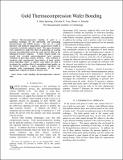| dc.contributor.author | Spearing, S. Mark | |
| dc.contributor.author | Tsau, Christine H. | |
| dc.contributor.author | Schmidt, Martin A. | |
| dc.date.accessioned | 2003-12-13T16:41:31Z | |
| dc.date.available | 2003-12-13T16:41:31Z | |
| dc.date.issued | 2004-01 | |
| dc.identifier.uri | http://hdl.handle.net/1721.1/3828 | |
| dc.description.abstract | Thermocompression bonding of gold is a promising technique for the fabrication and packaging microelectronic and MEMS devices. The use of a gold interlayer and moderate temperatures and pressures results in a hermetic, electrically conductive bond. This paper documents work conducted to model the effect of patterning in causing pressure non-uniformities across the wafer and its effect on the subsequent fracture response. A finite element model was created that revealed pattern-dependent local pressure variations of more than a factor of three. This variation is consistent with experimental observations of bond quality across individual wafers A cohesive zone model was used to investigate the resulting effect of non-uniform bond quality on the fracture behavior. A good, qualitative agreement was obtained with experimental observations of the load-displacement response of bonds in fracture tests. | en |
| dc.description.sponsorship | Singapore-MIT Alliance (SMA) | en |
| dc.format.extent | 918454 bytes | |
| dc.format.mimetype | application/pdf | |
| dc.language.iso | en_US | |
| dc.relation.ispartofseries | Advanced Materials for Micro- and Nano-Systems (AMMNS); | |
| dc.subject | wafer bonding | en |
| dc.subject | thermocompression | en |
| dc.subject | cohesive zone | en |
| dc.title | Gold Thermocompression Wafer Bonding | en |
| dc.type | Article | en |
